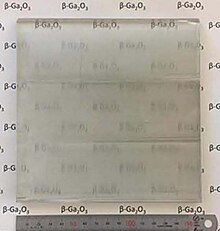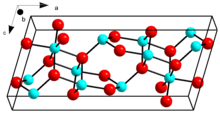
Back Gallium(III)oksied Afrikaans أكسيد الغاليوم الثلاثي Arabic اوکسید قالیوم (III) AZB Triòxid de gal·li Catalan Oxid gallitý Czech Gallium(III)-oxid German اکسید گالیم (III) Persian Galliumoksidi Finnish Oxyde de gallium(III) French 酸化ガリウム(III) Japanese
 β-Ga2O3 crystal
| |
 Crystal structure of β-Ga2O3
| |
| Names | |
|---|---|
| Other names
gallium trioxide, gallium sesquioxide
| |
| Identifiers | |
3D model (JSmol)
|
|
| ChemSpider | |
| ECHA InfoCard | 100.031.525 |
| EC Number |
|
PubChem CID
|
|
| RTECS number |
|
| UNII | |
CompTox Dashboard (EPA)
|
|
| |
| |
| Properties | |
| Ga2O3 | |
| Molar mass | 187.444 g/mol |
| Appearance | white crystalline powder |
| Melting point | 1,725 °C (3,137 °F; 1,998 K)[1] |
| insoluble | |
| Solubility | soluble in most acids |
| Structure[2][3] | |
| Monoclinic, mS20, space group = C2/m, No. 12 | |
a = 1.2232 nm, b = 0.3041 nm, c = 0.5801 nm α = 90°, β = 103.73°, γ = 90° β-phase
| |
Formula units (Z)
|
4 |
| Thermochemistry[4] | |
Heat capacity (C)
|
92.1 J/(mol·K) |
Std molar
entropy (S⦵298) |
85.0 J/(mol·K) |
Std enthalpy of
formation (ΔfH⦵298) |
−1089.1 kJ/mol |
Gibbs free energy (ΔfG⦵)
|
−998.3 kJ/mol |
Enthalpy of fusion (ΔfH⦵fus)
|
100 kJ/mol |
Except where otherwise noted, data are given for materials in their standard state (at 25 °C [77 °F], 100 kPa).
| |
Gallium(III) oxide is an inorganic compound and ultra-wide-bandgap semiconductor with the formula Ga2O3. It is actively studied for applications in power electronics, phosphors, and gas sensing.[5][6][7] The compound has several polymorphs, of which the monoclinic β-phase is the most stable. The β-phase’s bandgap of 4.7–4.9 eV and large-area, native substrates make it a promising competitor to GaN and SiC-based power electronics applications and solar-blind UV photodetectors.[7][8] The orthorhombic ĸ-Ga2O3 is the second most stable polymorph. The ĸ-phase has shown instability of subsurface doping density under thermal exposure.[9] Ga2O3 exhibits reduced thermal conductivity and electron mobility by an order of magnitude compared to GaN and SiC, but is predicted to be significantly more cost-effective due to being the only wide-bandgap material capable of being grown from melt.[7][10][11] β-Ga2O3 is thought to be radiation-hard, which makes it promising for military and space applications.[12][13]
- ^ Patnaik, Pradyot (2002) Handbook of Inorganic Chemicals. McGraw-Hill. ISBN 0-07-049439-8.
- ^ Dohy, D.; Gavarri, J. R. (1983). "Oxyde β-Ga2O3: Champ de force, dilatation thermique, et rigidité anisotropes". Journal of Solid State Chemistry (in French). 49 (1): 107–117. Bibcode:1983JSSCh..49..107D. doi:10.1016/0022-4596(83)90222-0.
- ^ Geller, S. (1 September 1960). "Crystal Structure of β-Ga2O3". The Journal of Chemical Physics. 33 (3): 676–684. Bibcode:1960JChPh..33..676G. doi:10.1063/1.1731237.
- ^ Haynes, William M., ed. (2011). CRC Handbook of Chemistry and Physics (92nd ed.). Boca Raton, FL: CRC Press. pp. 5.20, 6.157. ISBN 1-4398-5511-0.
- ^ Lin, Jianhua; Zhou, Liuyan; Shen, Yuyu; Fu, Jie; Chen, Yanling; Lei, Lei; Ye, Renguang; Shen, Yang; Deng, Degang; Xu, Shiqing (10 December 2022). "[Zn2+-Ge4+] co-substitutes [Ga3+-Ga3+] to coordinately broaden the near-infrared emission of Cr3+ in Ga2O3 phosphors". Physical Chemistry Chemical Physics. 25 (3): 2090–2097. doi:10.1039/D2CP04737C. PMID 36562283. S2CID 254561209.
- ^ Liu, Zhifu; Yamazaki, Toshinari; Shen, Yanbai; Kikuta, Toshio; Nakatani, Noriyuki; Li, Yongxiang (22 February 2008). "O2 and CO sensing of Ga2O3 multiple nanowire gas sensors". Sensors and Actuators B: Chemical. 129 (2): 666–670. doi:10.1016/j.snb.2007.09.055.
- ^ a b c Green, Andrew J.; Speck, James; Xing, Grace; Moens, Peter; Allerstam, Fredrik; Gumaelius, Krister; Neyer, Thomas; Arias-Purdue, Andrea; Mehrotra, Vivek; Kuramata, Akito; Sasaki, Kohei; Watanabe, Shinya; Koshi, Kimiyoshi; Blevins, John; Bierwagen, Oliver (1 February 2022). "β-Gallium oxide power electronics". APL Materials. 10 (2): 029201. Bibcode:2022APLM...10b9201G. doi:10.1063/5.0060327. S2CID 246660179.
- ^ Pavesi, M. (2018). "ε-Ga2O3 epilayers as a material for solar-blind UV photodetectors". Materials Chemistry and Physics. 205: 502–507. doi:10.1016/j.matchemphys.2017.11.023.
- ^ Rajabi Kalvani, Payam; Parisini, Antonella; Sozzi, Giovanna; Borelli, Carmine; Mazzolini, Piero; Bierwagen, Oliver; Vantaggio, Salvatore; Egbo, Kingsley; Bosi, Matteo; Seravalli, Luca; Fornari, Roberto (4 October 2023). "Interfacial Properties of the SnO/κ-Ga 2 O 3 p-n Heterojunction: A Case of Subsurface Doping Density Reduction via Thermal Treatment in κ-Ga 2 O 3". ACS Applied Materials & Interfaces. 15 (39): 45997–46009. doi:10.1021/acsami.3c08841. ISSN 1944-8244. PMC 10561148. PMID 37733937.
- ^ Reese, Samantha B.; Remo, Timothy; Green, Johney; Zakutayev, Andriy (17 April 2019). "How Much Will Gallium Oxide Power Electronics Cost?". Joule. 3 (4): 903–907. doi:10.1016/j.joule.2019.01.011. S2CID 127789383.
- ^ Heinselman, Karen N.; Haven, Drew; Zakutayev, Andriy; Reese, Samantha B. (3 August 2022). "Projected Cost of Gallium Oxide Wafers from Edge-Defined Film-Fed Crystal Growth". Crystal Growth & Design. 22 (8): 4854–4863. doi:10.1021/acs.cgd.2c00340.
- ^ Bauman, D. A.; Borodkin, A. I.; Petrenko, A. A.; Panov, D. I.; Kremleva, A. V.; Spiridonov, V. A.; Zakgeim, D. A.; Silnikov, M. V.; Odnoblyudov, M. A.; Romanov, A. E.; Bougrov, V. E. (1 March 2021). "On improving the radiation resistance of gallium oxide for space applications". Acta Astronautica. 180: 125–129. Bibcode:2021AcAau.180..125B. doi:10.1016/j.actaastro.2020.12.010. S2CID 230578016.
- ^ Pearton, Stephen J.; Ren, Fan; Law, Mark; Mastro, Michael (2021). Fundamental Studies and Modeling of Radiation Effects in beta-Gallium Oxide. Defense Threat Reduction Agency, U.S.